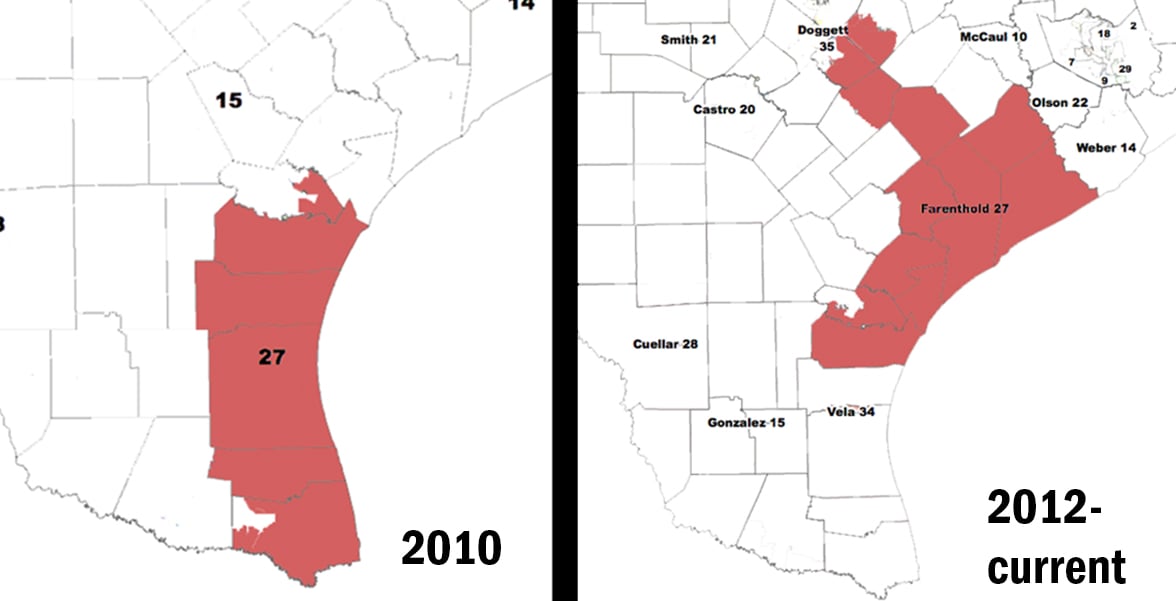
Blake Farenthold and the Consequences of Extreme Gerrymandering
How the Corpus Christi Republican, who abruptly resigned from Congress this week, benefited from a discriminatory redistricting plan that’s now before the Supreme Court.

Blake Farenthold’s frat bro image started with a photo from an adult pajama party that surfaced a month before his unlikely rise to Congress in 2010. Thanks to Farenthold, the image of a portly, rosy-cheeked man stuffed into a duck-pattern onesie posing next to a young lingerie-clad waitress is now forever burned into the collective memory of Texas politics.
This is Congressman Blake Farenthold (in the duck onesie) #txlege pic.twitter.com/F5fWDmUnIt
— Kolten Parker (@KoltenParker) December 1, 2017
A lawsuit lodged against the Corpus Christi Republican, filed not long after BuzzFeed revealed that Farenthold’s computer consulting business bought up domains like “blow-me.org,” further fueled the congressman’s party boy reputation. The complaint, by former communications director Lauren Greene, alleged that Farenthold’s excessive drinking and office sex-talk had created a toxic work environment where he’d dish to staffers about his “sexual fantasies” and “wet dreams” (Greene also alleged Farenthold cracked a thinly veiled joke about her having semen on her skirt). Farenthold later became one of the only GOP officials willing to publicly defend Donald Trump’s pussy-grabbing “locker room banter” ahead of the 2016 election. When one talk show host asked if he’d support a candidate who talked about raping women, Farenthold responded, “It depends.”
By late 2017, however, Farenthold’s political career, one filled with more gaffes than legislative accomplishments, took an even sharper nosedive when news broke that he’d settled Greene’s sexual harassment lawsuit with $84,000 of taxpayer money. While Farenthold has denied any wrongdoing and insisted he’s a misunderstood shy guy, he nevertheless abruptly resigned from Congress last week upon learning that a House Ethics Committee investigation into his behavior would not end well, as first reported by the Huffington Post.
How did Farenthold hold on to his seat for so long? Maybe he was simply a shining example of a statesman truly in touch with the people. The more likely answer: He was the beneficiary of extreme gerrymandering.
Texas has continued to use the deliberately discriminatory maps for six years while the state appealed those rulings all the way to the Supreme Court.
When Farenthold won his seat in 2010, it was seen as a major upset. Step-grandson of Texas Democratic legend Sissy Farenthold and a conservative radio host, Farenthold narrowly beat Solomon Ortiz, the 14-term Democratic incumbent, by nearly 800 votes. With virtually no chance Farenthold could hold the seat in 2012, a higher-turnout presidential election year, Texas Republicans simply gifted him a safer district during the 2011 Legislature’s post-Census map-drawing process.
As the Texas Tribune explains this week, that meant literally flipping Farenthold’s district south to north. Before, the district stretched from Corpus Christi to the Mexico border — a corridor that was 69 percent Latino. Republican map-drawers lopped off the southern reach of the district, replacing all those Democratic-leaning Hispanics in the Rio Grande Valley with Anglos along the Coastal Bend and into Central Texas. The new Congressional District 27, which aptly resembled a mangled fist flashing a big middle finger, now contained a strong GOP electorate that would all but ensure Farenthold’s re-election. While Farenthold barely won in 2010, he’s sailed to re-election every subsequent cycle, most recently with 62 percent of the vote in 2016.

Those changes created district maps that “intentionally deprived” Hispanics in the region from electing their candidate of choice, according to lower court rulings that have largely sided with a civil rights groups challenging Texas’ redistricting plan. Farenthold’s is one of several state and congressional districts that judges have ruled were deliberately drawn to discriminate against minority voters. As I’ve written before, those repeat findings of intentional discrimination, should they survive the U.S. Supreme Court, could force Texas to clear any future voting laws changes with the feds.
Texas has continued to use the deliberately discriminatory maps for six years while the state appealed those rulings all the way to the Supreme Court. Which means the thousands of Hispanic voters “stranded” in the reconfigured 27th Congressional District were stuck with Farenthold for three subsequent election cycles.
Depending on how the Supreme Court rules, Farenthold’s old district may shift again. However, voting laws experts say that even if the high court orders more changes to the maps, those probably won’t come until after the 2018 election, meaning one of two candidates running for the GOP nomination will almost certainly take the seat Farnethold just abandoned.
While Congressional District 27 could look different in 2020, a new post-Census round of redistricting begins the following year, when lawmakers will once again be looking to create safe spaces for gems like Farenthold.


